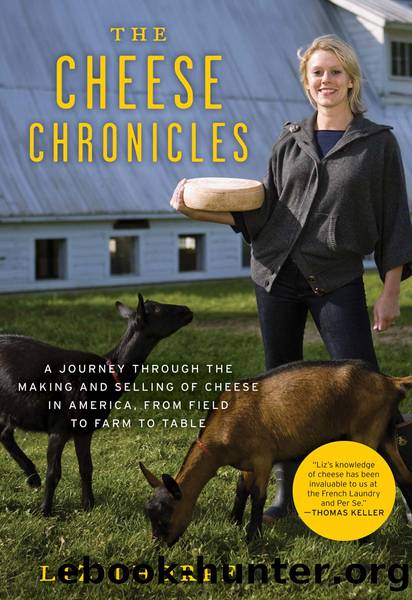The Cheese Chronicles by Liz Thorpe

Author:Liz Thorpe
Language: eng
Format: epub
Publisher: HarperCollins
Published: 2009-01-15T00:00:00+00:00
COACH FARM
PINE PLAINS, NEW YORK
The story of Coach Farm is about as good as it gets in the cheese world: money, drama, famous chefs, and lots of goats. The farm was among the first of the ânew waveâ and in 1983 wound up being the supplier of local fresh chèvre to New York City. I wouldnât say (and I donât think Miles and Lillian Cahn would say either) that this was the original intention. In the beginning, Miles and Lillian decided to buy a country property, which lots of New Yorkers do. This particular couple was sitting pretty high on the hog, having taken a little family leather goods company and grown it into the famed Coach handbags. They were going to have a farm and shuttle between New York and the Hudson Valley. Like many folks who stumbled into farms and cheese around that time, they self-admittedly had no idea what they were doing.
I get the impression that when Miles Cahn does things, he does them big. Not only did they buy some property, they bought a 300-plus-acre parcel. This happened to be in an area where dairy farms were closing right and left even as the Cahns decided to actively farm their plot. Miles wrote a great little book called The Perils and Pleasures of Domesticating Goat Cheese, and when I called him to talk, he said, âWhy donât you just read my book?â The thing about Milesâs book is that it describes the phenomenon of Coach cheese as a funny accident that just sort of happened. But you donât wind up with 300 acres of land and more than eight hundred goats by accident, no matter how fertile they are. It turns out the land was really beautiful, and they figured they would farm it and turn the hay they grew into something more valuable. Theyâd pass it through an animal, turn it into milk, and turn the milk into cheese. Given all the cow dairy closures, they began to consider goats.
Hereâs where Miles the Businessman isnât entirely present in his book. The âaccidentâ of all those goats was actually the result of this incredibly savvy guy looking around at his new, gigantic piece of land and realizing that if he was going to make more money with animals than with hay, he was going to need a lot of animals. The investment in equipment, facilities, French cheesemakers, packaging, trucks, and so on couldnât be sustained with a dozen goats. No way. This was the couple who took their rinky-dink company and turned it into an international brand. If they were going to make cheese, it would be major. From the outset, they built a barn for eight hundred goats, intending to keep a closed herd, meaning they would breed their does and grow the herd organically, rather than bringing in goats from the outside. (Farms can do this and avoid seriously inbred animals by artificially inseminating. In the process, the male animals are selected for the desirable genetic characteristics they can impart, from fat and protein content to longevity.
Download
This site does not store any files on its server. We only index and link to content provided by other sites. Please contact the content providers to delete copyright contents if any and email us, we'll remove relevant links or contents immediately.
| Cheese & Dairy | Chocolate |
| Fish & Seafood | Fruits |
| Herbs, Spices & Condiments | Meat & Game |
| Natural Foods | Pasta & Noodles |
| Potatoes | Poultry |
| Rice & Grains | Vegetables |
The Sprouting Book by Ann Wigmore(3543)
Better Homes and Gardens New Cookbook by Better Homes & Gardens(3523)
Trullo by Tim Siadatan(3378)
Super Food Family Classics by Jamie Oliver(3366)
Hedgerow by John Wright(3274)
Panini by Carlo Middione(3248)
Bread Revolution by Peter Reinhart(3080)
Sauces by James Peterson(3048)
Jam by Jam (epub)(3020)
Ottolenghi - The Cookbook by Yotam Ottolenghi(2869)
Oh She Glows Every Day by Angela Liddon(2726)
My Pantry by Alice Waters(2542)
Hot Sauce Nation by Denver Nicks(2450)
The Culinary Herbal by Susan Belsinger(2429)
Veg by Jamie Oliver(2408)
Wanderlust by Jeff Krasno(2225)
Meathooked by Marta Zaraska(2220)
The Art of Making Gelato by Morgan Morano(2215)
Basic Illustrated Edible and Medicinal Mushrooms by Jim Meuninck(2185)
